
A maxi yacht usually refers to a racing yacht of at least 21 metres (70 ft) in length.

The Fastnet Race is a biennial offshore yacht race organised by the Royal Ocean Racing Club (RORC) of the United Kingdom with the assistance of the Royal Yacht Squadron in Cowes and the City of Cherbourg in France.
Performance Handicap Racing Fleet (PHRF) is a handicapping system used for yacht racing in North America. It allows dissimilar classes of sailboats to be raced against each other. The aim is to cancel out the inherent advantages and disadvantages of each class of boats, so that results reflect crew skill rather than equipment superiority.

Ronald John Holland is a yacht designer, who came to prominence in the 1970s with his successful racing designs, and is now best known for his superyachts such as Mirabella V and Ethereal. He is now based in Vancouver, British Columbia, Canada.
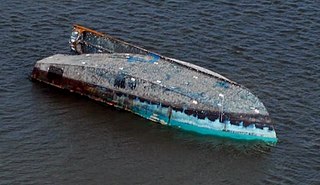
In dinghy sailing, a boat is said to be turtling or to turn turtle when the boat is fully inverted with the mast pointing down to the lake bottom, riverbed, or seabed. The name stems from the appearance of the upside-down boat, similar to the carapace of a sea turtle. The term can be applied to any vessel; turning turtle is less frequent but more dangerous on ships than on smaller boats. It is rarer but more hazardous for multihulls than for monohulls, because of multihulls are harder to flip in both directions. Measures can be taken to prevent a capsize from becoming a turtle.
Gary Mull was an American yacht designer who created many popular fiberglass sailboats.

The Contessa 32 is a 9.75 metre (32 ft) fibreglass monohull sailing yacht, designed in 1970 by David Sadler in collaboration with yachtbuilder Jeremy Rogers, as a larger alternative to the Contessa 26. With over 750 hulls built, the yacht has become the most successful one-design cruiser-racer of all time. The yachts have a masthead sloop rig, with a fin keel and a skeg-mounted rudder, a cutting edge concept for the period which now represents a cross between newer and older designs.
International Rating Certificate (IRC) is a system of handicapping sailboats and yachts for the purpose of racing. It is managed by the Royal Ocean Racing Club (RORC) in the United Kingdom through their dedicated Rating Office, and the Union Nationale pour la Course au Large (UNCL) in France.
In sailing, the limit of positive stability (LPS) or angle of vanishing stability (AVS) is the angle from the vertical at which a boat will no longer stay upright but will capsize, becoming inverted, or turtled.

A sailing yacht, is a leisure craft that uses sails as its primary means of propulsion. A yacht may be a sail or power vessel used for pleasure, cruising, or racing. There is no standard definition, so the term applies here to sailing vessels that have a cabin with amenities that accommodate overnight use. To be termed a "yacht", as opposed to a "boat", such a vessel is likely to be at least 33 feet (10 m) in length and have been judged to have good aesthetic qualities. Sailboats that do not accommodate overnight use or are smaller than 30 feet (9.1 m) are not universally called yachts. Sailing yachts in excess of 130 feet (40 m) are generally considered to be superyachts.
The International Measurement System (IMS) is a system of handicapping sailboats for the purpose of racing that replaced the earlier International Offshore Rule (IOR) system in the early 1990s. It is managed by the Offshore Racing Congress (ORC). In the sailing world it is usually referred to simply as 'IMS'.
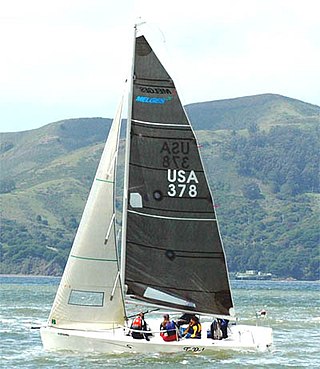
The term sportsboat first appeared in the late 1980s and early 1990s to describe trailer sailers that were optimised for high performance at the expense of accommodation and ballast. The very definition of the term "sportsboat" is evolving.
The Seaway 25 was designed by Doug Peterson of USA fame for Tom Stevenson in 1978 after Tom won the World half Ton championship in one of Doug's designs. The yacht was designed to sail well on the short sharp chop of Port Phillip Bay Melbourne Australia. Intended to rate as a quarter ton Trailer yacht under IOR and Junior Offshore Group racing both for Harbour and Inshore Yacht racing.

The 1993 Sydney to Hobart Yacht Race was the 49th annual running of the Australian "blue water classic" Sydney to Hobart Yacht Race. It was hosted by the Cruising Yacht Club of Australia based in Sydney.
A velocity prediction program (VPP) is a computer program which solves for the performance of a sailing yacht in various wind conditions by balancing hull and sail forces. VPPs are used by yacht designers, boat builders, model testers, sailors, sailmakers, also America's Cup teams, to predict the performance of a sailboat before it has been built or prior to major modifications.
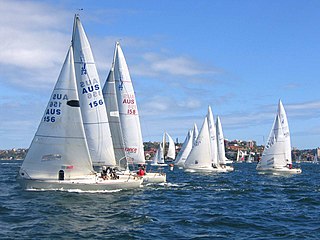
The sport of sailing involves a variety of competitive sailing formats that are sanctioned through various sailing federations and yacht clubs. Racing disciplines include matches within a fleet of sailing craft, between a pair thereof or among teams. Additionally, there are specialized competitions that include setting speed records. Racing formats include both closed courses and point-to-point contests; they may be in sheltered waters, coast-wise or on the open ocean. Most competitions are held within defined classes or ratings that either entail one type of sailing craft to ensure a contest primarily of skill or rating the sailing craft to create classifications or handicaps.
The Offshore Racing Congress (ORC) is an international body for the sport of competitive sailing and is responsible for the establishment and maintenance of rating and classification standards used to define offshore, that is marine as opposed to inland, yacht racing handicap categories.
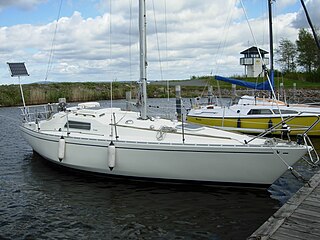
Half Ton class was an offshore sailing class of the International Offshore Rule racing the Half Ton Cup between 1967 and 1993.
Handicap forms for sailing vessels in sailing races have varied throughout history, and they also vary by country, and by sailing organisation. Sailing handicap standards exist internationally, nationally, and within individual sailing clubs.
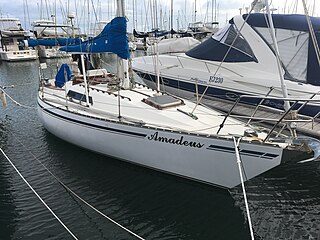
UFO 34 is a cruising and racing fibreglass monohull sailboat class. It is a sloop based on a design by Holman and Pye. The design features a spade rudder and a Bermuda rig with a large, overlapping headsail. Over 150 UFO 34s have been built both in the United Kingdom and Australia.










